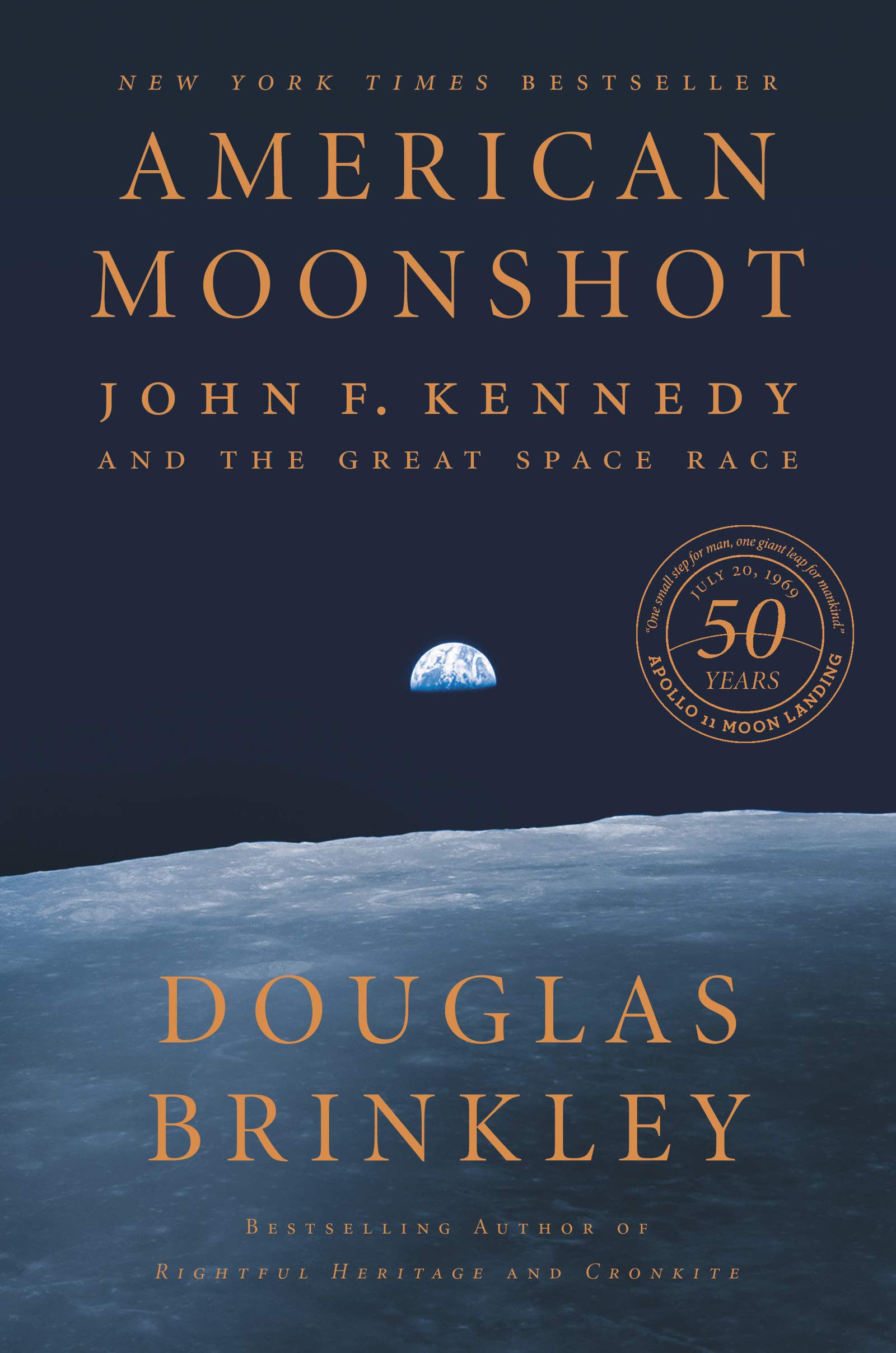
On April 12th, 1961, Soviet cosmonaut Yuri Gagarin became the first human being in space. Making his trip in the 10,395-pound vehicle Vostok 1, Gagarin orbited the Earth for 108 minutes before returning safely. In addition, this date coincides with the first American space shuttle launch in 1981. The library has put together a reading list to help you explore the fascinating history of the space race, the moon landing, and humankind’s ongoing attempt to explore space.
“On May 25, 1961, JFK made an astonishing announcement: his goal of putting a man on the moon by the end of the decade. In this engrossing, fast-paced epic, Douglas Brinkley returns to the 1960s to recreate one of the most exciting and ambitious achievements in the history of humankind. American Moonshot brings together the extraordinary political, cultural, and scientific factors that fueled the birth and development of NASA and the Mercury, Gemini and Apollo projects, which shot the United States to victory in the space race against the Soviet Union at the height of the Cold War.
Drawing on new primary source material and major interviews with many of the surviving figures who were key to America’s success, Brinkley brings this fascinating history to life as never before. American Moonshot is a portrait of the brilliant men and women who made this giant leap possible, the technology that enabled us to propel men beyond earth’s orbit to the moon and return them safely, and the geopolitical tensions that spurred Kennedy to commit himself fully to this audacious dream. Brinkley’s ensemble cast of New Frontier characters include rocketeer Wernher von Braun, astronaut John Glenn and space booster Lyndon Johnson.” –Goodreads.com
“Set amid the civil rights movement, the never-before-told true story of NASA’s African-American female mathematicians who played a crucial role in America’s space program. Before Neil Armstrong walked on the moon, a group of professionals worked as ‘Human Computers’, calculating the flight paths that would enable these historic achievements. Among these were a coterie of bright, talented African-American women. Segregated from their white counterparts, these ‘coloured computers’ used pencil and paper to write the equations that would launch rockets and astronauts, into space. Moving from World War II through NASA’s golden age, touching on the civil rights era, the Space Race, the Cold War and the women’s rights movement, ‘Hidden Figures’ interweaves a rich history of mankind’s greatest adventure with the intimate stories of five courageous women whose work forever changed the world.” -Goodreads.com
“In early 1968, the Apollo program was on shaky footing. President Kennedy’s end-of-decade deadline to put a man on the Moon was in jeopardy, and the Soviets were threatening to pull ahead in the space race. By August 1968, with its back against the wall, NASA decided to scrap its usual methodical approach and shoot for the heavens. With just four months to prepare–a fraction of the normal time–the agency would send the first men in history to the Moon. In a year of historic violence and discord–the Tet offensive, the assassinations of MLK and RFK, the Chicago DNC riots–the Apollo 8 mission was the boldest test of what America could do. With a focus on astronauts Frank Borman, Jim Lovell, and Bill Anders, and their wives and children, this is a vivid, gripping, you-are-there narrative that shows anew the epic danger involved, and the singular bravery it took, for man to leave Earth for the first time–and to arrive at a new world.” -Goodreads.com
“On July 20, 1969, Neil Armstrong and Buzz Aldrin became the first humans to walk on the Moon, a moment forever ingrained in history. Perhaps the world’s greatest technological achievement-and a triumph of American spirit and ingenuity-the Apollo 11 mission, and the entire Apollo program, was a mammoth undertaking involving more than 410,000 men and women dedicated to putting a man on the Moon and winning the Space Race against the Soviets.
Seen through the eyes of the those who lived it, Shoot for the Moon reveals the dangers, the challenges, and the sheer determination that defined not only Apollo 11, but also the Mercury and Gemini missions that made it possible. Both sweeping and intimate, and based on exhaustive research and dozens of fresh interviews, bestselling author James Donovan’s Shoot for the Moon is the definitive and thrilling account of one of humankind’s most extraordinary feats of exploration.” -Goodreads.com
“The Smithsonian History of Space Exploration is a comprehensive history of international space exploration paired with photographs, illustrations, graphics, and sidebars on key scientific and technological developments, influential figures, and pioneering spacecraft. Former NASA and Smithsonian space curator and historian Roger D. Launius presents human’s endeavors to understand the universe, honoring millennia of human curiosity, ingenuity, and achievement.
The book examines space exploration’s origins in the pioneering work undertaken by the ancients of Greece, Rome, and China, and moves through the great discoveries of Renaissance thinkers including Copernicus, Galileo, and Kepler. It offers new insight into well-known moments such as the launch of Sputnik 1 and the Apollo Moon landing and explores the unexpected events and hidden figures of space history.
Presenting the technological and mechanical breakthroughs enabling humans to explore far beyond our own planet in recent decades, it also speculates on the future of space exploration, including space tourism and our possible future as an extraterrestrial species. This is a must-read for space buffs and everyone intrigued by the history and future of scientific discovery.” -Goodreads.com
“Within the pages of this eclectic pop-history, scientist and educator Sten Odenwald at NASA examines 100 objects that forever altered what we know and how we think about the cosmos. From Sputnik to Skylab and Galileo’s telescope to the Curiosity rover, some objects are iconic and some obscure—but all are utterly important.
The Nebra sky disk (1600 BCE) features the first realistic depiction of the Sun, Moon, and stars.
The Lunar Laser Ranging RetroReflectorfinally showed us how far we are from the Moon in 1969.
In 1986, it was the humble, rubber O-ring that doomed the space shuttle Challenger.
The Event Horizon Telescope gave us our first glimpse of a black hole in 2019.
These 100 objects, as Odenwald puts it, showcase ‘the workhorse tools and game-changing technologies that have altered the course of space history . . . the tools and devices that, taken together, represent the major scientific discoveries—and celebrate the human ingenuity—of space technology, showing the ways physics and engineering have brought about our greatest leaps in understanding the way our universe works. . . . They make it clear that we have made giant strides in our quest to search ever more deeply into the farthest reaches of the universe—and behind each new discovery is an object that expands our appreciation of space as well as the boundless imagination and resourcefulness we carry within us.'” -Goodreads.com
If you have any questions about putting these books on hold, please leave a comment below, call 732-873-8700 ext. 111, or message us on our chat service found on our website.
Thanks for reading,
George, FTPL










